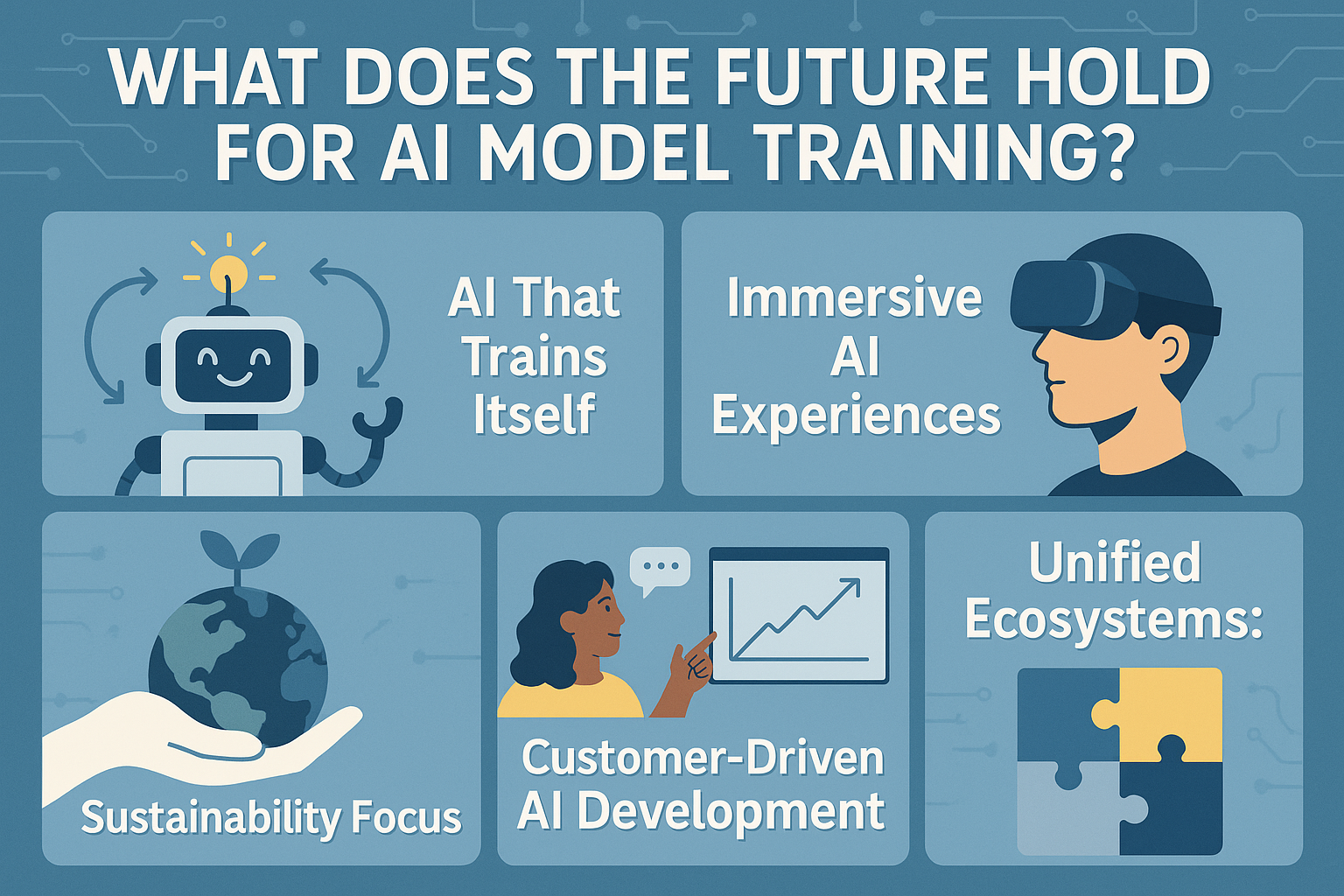Artificial intelligence (AI) powers everything from chatbots and recommendation engines to self-driving cars and fraud detection systems. But behind every successful AI product lies one critical step: how to train an AI model. This process transforms raw data into a powerful system capable of learning, adapting, and solving complex problems.
In today’s fast-paced business environment, AI is no longer reserved for tech giants. Small and mid-sized companies are now leveraging AI to automate processes, improve customer experience, and gain competitive advantages. But to make AI work effectively, you need a clear plan for training models.
This comprehensive guide will explain how to train an AI model, break down the essential steps, highlight benefits and challenges, explore tools and trends, and help you prepare for the future of AI development.
What Is AI Model Training?
AI model training is the process of teaching a machine learning algorithm to recognize patterns and make predictions by feeding it data. It’s similar to how humans learn, by being exposed to examples and refining understanding over time. When comparing AI vs machine learning, it's important to understand that while AI encompasses a wide range of technologies, machine learning is specifically the technique used to train models to identify patterns in data.
Training involves adjusting a model’s internal parameters so it can process new inputs and deliver accurate outputs. For example:
- An image recognition model learns to identify cats and dogs by studying thousands of labeled pictures.
- A natural language processing (NLP) model learns to understand text by analyzing massive datasets of written language.
AI training is often divided into training, validation, and testing phases to ensure the model learns correctly and generalizes well to unseen data.
For businesses in fast-moving industries like technology, building a strong AI model isn’t just about data; it’s about telling the right story and reaching the right audience. Partnering with a tech marketing agency can help position your AI solutions effectively from launch.
6 Core Steps to Train an AI Model
Training an AI model can seem overwhelming, but breaking it down into key steps makes it manageable.
 Here’s a proven roadmap:
Here’s a proven roadmap:
1. Define the Problem Clearly
Start by framing the business problem. Are you trying to classify emails, predict customer churn, or detect objects in images? A well-defined goal guides the data you collect and the model you select.
2. Collect and Prepare Data
Data is the foundation of AI. Collect data from reliable sources, customer transactions, sensor logs, public datasets, or APIs. Then, clean and preprocess it by:
- Removing duplicates and irrelevant records.
- Handling missing values.
- Normalizing or scaling data for better model performance.
3. Choose the Right Model
Different problems require different models. Options range from decision trees and logistic regression to deep neural networks and transformers. Start simple and scale complexity as needed.
4. Train and Fine-Tune
Feed your prepared data into the chosen algorithm. Use training data to adjust model weights until it learns to make accurate predictions. Hyperparameter tuning helps refine performance.
5. Validate and Test
Split your data into training, validation, and testing sets. This ensures the model performs well on new, unseen data and doesn’t just memorize training examples.
6. Deploy and Monitor
Once your model meets performance benchmarks, deploy it to production systems. Continuously monitor accuracy and retrain with new data to keep it relevant.
To streamline these stages and modernize operations, many companies invest in digital transformation strategies that integrate AI efficiently across teams and workflows.
Explore Our Web Design & Development Serviecs!
5 Benefits of Training AI Models for Business
Investing in AI model training offers transformative value for organizations of all sizes:
1. Smarter Decision-Making
AI models analyze massive datasets to uncover insights humans might miss, enabling faster, data-driven decisions.
2. Operational Efficiency
Automation powered by AI reduces manual work, saves time, and cuts costs across departments.
3. Enhanced Customer Experience
From chatbots to personalized recommendations, AI delivers seamless, engaging interactions.
4. Innovation & Competitive Advantage
Companies that harness AI stay ahead by creating smarter products and services.
5. Scalable Growth
Well-trained AI models can handle increasing complexity and user demand without requiring proportional human effort.
To fully realize these benefits, businesses often use digital marketing services to communicate AI-driven innovations and attract the right audience.
What Challenges Do Companies Face When Training AI Models?
Training AI models is powerful but far from simple, and many companies encounter similar hurdles along the way.
One of the most common challenges is data scarcity or poor quality, as finding clean, well-labeled, and representative datasets can be difficult and time-consuming.
Another obstacle is the high computational cost of training large models, which often requires expensive hardware or scalable cloud infrastructure.
Businesses also face concerns around bias and fairness, since models trained on unbalanced data can produce inaccurate or even discriminatory results.
On top of that, security and privacy risks remain a priority when handling sensitive information, especially under strict compliance regulations.
Finally, gaining stakeholder buy-in can be tricky when leaders or clients struggle to understand complex AI decisions.
Premium brands that want to innovate while maintaining a polished, exclusive image often work with a luxury branding agency to communicate the value of their AI tools effectively and inspire confidence among customers.
What Are the 5 Best Practices for Successful AI Model Training?
To avoid costly mistakes and improve outcomes, follow these best practices:
- Start with a Clear Business Goal: Focus on solving a specific problem rather than chasing trends.
- Use Diverse, Balanced Data: Reduce bias and improve model generalization.
- Experiment with Multiple Models: Test various algorithms to find the best fit.
- Validate Often: Use cross-validation and hold-out sets to prevent overfitting.
- Monitor Post-Deployment: Continuously track performance and update the model as data evolves.
For brands looking to craft compelling narratives around AI-powered solutions, expert creative services can help simplify complex concepts and drive adoption.
What Tools & Frameworks Help Train AI Models?
Building AI models is much more manageable with the right tools and frameworks. Popular open-source libraries and frameworks like TensorFlow, PyTorch, Keras, and Scikit-learn help data scientists create, train, and fine-tune models efficiently.
For scalability and ease of deployment, businesses often turn to cloud platforms such as AWS SageMaker, Google Vertex AI, and Microsoft Azure Machine Learning, which offer prebuilt environments and advanced computing power.
Tools for data labeling, like Labelbox and Scale AI, ensure high-quality training datasets, while MLOps platforms such as MLflow and Kubeflow streamline experimentation and lifecycle management.
For SEO optimization of AI-driven tools, using best AI SEO software can enhance visibility and ensure that your solutions are discovered by the right audience, optimizing both performance and reach.
What Role Does Data Play in AI Model Training?
Data is the single most important factor in AI success. High-quality, representative datasets enable accurate predictions. Consider:
- Volume: More data generally leads to better models.
- Variety: Diverse data prevents bias and improves adaptability.
- Quality: Clean, labeled, and relevant data drives precision.
- Privacy: Compliance with regulations like GDPR is essential.
When comparing AI vs human abilities, data plays a critical role in closing the gap between machine learning models and human understanding. Humans can often make connections between pieces of data quickly, while AI models require sufficient and high-quality data to make accurate decisions. Synthetic data generation and data augmentation techniques can fill gaps when real-world data is limited. For better visibility and traffic to your AI-driven offerings, expert SEO services ensure your solutions get discovered.
What Are the Latest Trends in AI Model Training?
AI development is evolving rapidly. Key trends include:
- Transfer Learning: Reusing pre-trained models saves time and resources.
- Low-Code / No-Code AI: Democratizing AI for non-technical users.
- Edge AI: Training and deploying models on devices for faster response times.
- Explainable AI (XAI): Making AI decisions more transparent and trustworthy.
- Federated Learning: Training across decentralized data sources to preserve privacy.
Companies in sectors like energy or manufacturing can stand out by working with an oil and gas marketing agency to showcase innovative AI use cases.
What Skills or Teams Are Needed to Train an AI Model?
Behind every successful AI initiative is a team with specialized expertise. Data scientists and machine learning engineers design and optimize algorithms, while data engineers create reliable pipelines to deliver clean, usable data.
AI ethicists play a growing role by ensuring models remain fair and unbiased, and UX designers craft interfaces that make AI-powered tools intuitive for end users.
DevOps and cloud experts help scale models securely in production environments, ensuring stability and performance. For those asking how to learn AI, there are a wealth of online resources and educational programs to help develop these crucial skills.
For companies aiming to expand globally or reach travel-savvy audiences, working with a travel marketing agency can help tailor AI-driven offerings and product launches to diverse international markets.
What Does the Future Hold for AI Model Training?
The future of AI model training is poised to be shaped by advancements in computational power, innovative techniques, and ethical considerations, driving more efficient, powerful, and responsible AI systems.

The future of AI training will be smarter, faster, and more accessible. Expect to see:
- AI That Trains Itself: AutoML will reduce technical barriers for businesses.
- Immersive AI Experiences: AR/VR combined with AI will change customer interactions.
- Sustainability Focus: Energy-efficient training will become essential.
- Customer-Driven AI Development: Feedback loops will refine models in real time.
- Unified Ecosystems: Seamless integration across data, analytics, and deployment platforms.
To stay ahead, companies are investing in advanced web design & development to create AI-powered digital platforms that stand out.
FAQs: How to Train an AI Model?
What is AI model training?
It’s the process of teaching an algorithm to learn from data so it can recognize patterns and make accurate predictions.
How much data do I need to train an AI model?
It depends on the complexity of your model; simple models may need thousands of records, while deep learning models often require millions.
What tools are best for AI model development?
Popular options include TensorFlow, PyTorch, Keras, and cloud platforms like AWS SageMaker and Google Vertex AI.
How long does it take to train an AI model?
Timelines vary from a few hours to several weeks, depending on data size, model complexity, and available computing power.
Can small businesses build their own AI models?
Yes. With accessible tools, cloud services, and pre-trained models, even small businesses can develop practical AI solutions.
Conclusion
Understanding how to train an AI model is essential for any organization looking to innovate and compete in a digital-first world. From defining a clear problem and collecting quality data to selecting the right algorithms and monitoring performance, a thoughtful approach to AI development can drive smarter decisions, improved efficiency, and transformative customer experiences. Yet, the journey doesn’t end with building a model; success depends on how you integrate AI into your brand, communicate its value, and adapt it as markets evolve.
That’s where Centric comes in. We help businesses craft cutting edge AI strategies, design intuitive digital platforms, and launch innovative technologies with impact. Whether you’re exploring AI for the first time or scaling advanced models to production, Centric ensures your solutions are not just powerful but positioned for real-world success.









